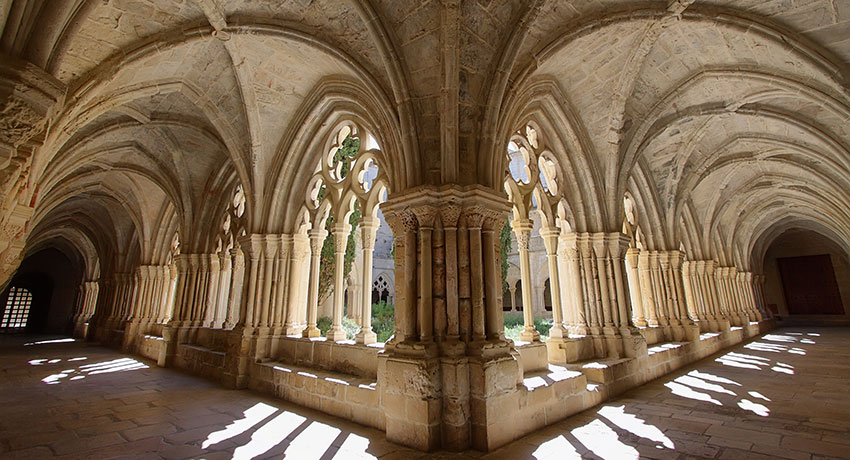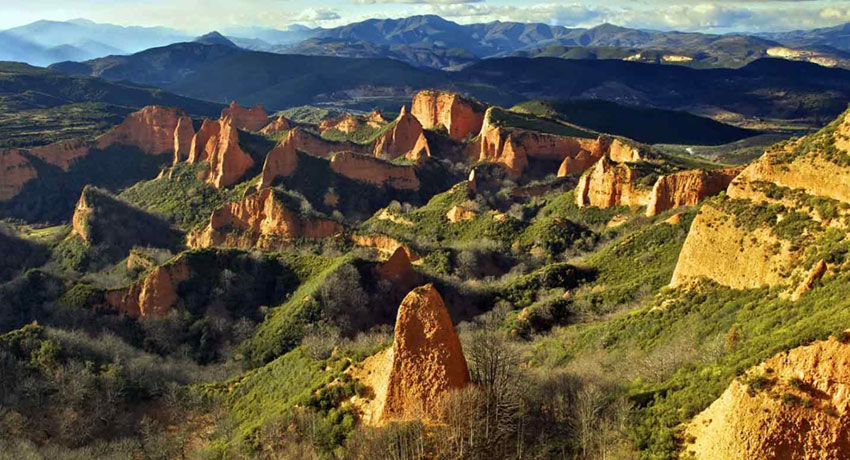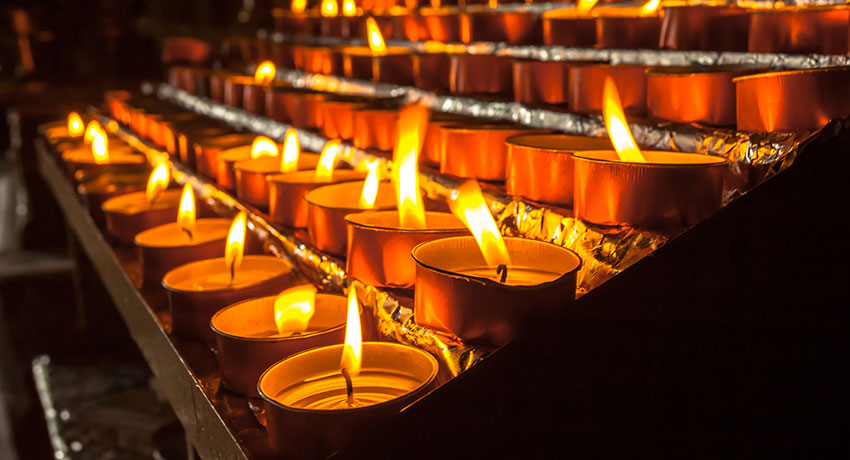Camino secrets
Spain is a country full of magic. Maybe it’s the feeling that life hasn’t changed much in thousands of years. Maybe it’s the history you feel while walking across Roman bridges or visiting a Visigoth castle. Maybe it’s the mystery of the myths and legends that surround so many little towns and each villager willing to tell you stories about them.
While walking the Camino brings you along an inward journey that brings you to a deeper meaning to life, exploring parts of Spain can help one appreciate the miraculous all around. From hidden gold mines, relics of Saints, to cloistered monasteries frozen in time, here are a few worthwhile day trips you can make while walking the Camino Frances.
Santo Domingo de Silos
About 300km from the start of the French Camino in St. Jean Pied de Port, you’ll find yourself walking into the city of Burgos. While Burgos is a fun city to explore and get to know, sometimes bigger cities are overwhelming for pilgrims who’ve walked in silence and stayed in small villages for long periods of time.
As Burgos is a popular spot to schedule a rest day or two, we recommend taking a day or overnight trip to the village of Santo Domingo de Silos. Located about 45 minutes south of Burgos, this small village has some famous history.
The original small-town church was built in the 11th century. Located in the middle of town, this church, named Iglesia el Cuerpo Santo (The Holy Body Church), has been restored and is used frequently today. Walking in you’ll see a dark church, with old stone pillars and a wooden roof. Aptly named, the body of the saint, relics of St. Dominic of Silos are preserved in the crypt and museum in the monastery.
More famous than the local church, is the Benedictine Monastery named after the saint, Abbey of St. Dominic of Silos. The monks that live there became famous in the ‘90s for releasing a CD of Gregorian chants that made the billboard charts worldwide.

Gregorian chants are said to have originated from this monastery and they can still be heard today. Sung at early morning mass and vespers, around 7pm, people come from all over to hear them. If attending mass, remember to wear nicer clothes than your hiking shorts.
The monastery itself is worth the visit alone and it’s a prime example of Romanesque art. Typical of Romanesque monasteries, in the middle is in an enclosed garden surrounded by carved columns. There’s a large Cypress tree right in the middle of the cloister and Spanish poet, Gerardo Vega, wrote a famous poem about it (below). Studying the poem, then seeing the tree in person, is a wonderful experience.

Guided tours are given daily in Spanish, and even if you don’t understand, take the tour for a behind the scenes look at the abbey. Sometimes even a monk will give a tour. There have a nice gift shop and it’s a great place to escape and recharge. There are a couple of local hotels and family restaurants and it’s off the tourist radar, so you’ll really feel like a local.
The Cypress of Silos
To Ángel del Río
Upright geyser of shade and slumber,
Who piques the sky with its spear.
A gushing spurt that all but reaches the stars
Unwinding in wild abandon.Mast of solitude, an island wonder,
An arrow of faith, a dart of hope,
Today I come to you, to the banks of Arlanza,
A chance pilgrim, my rudderless soul.When I saw your lonely, tender, firm frame,
I felt my anguish dissipate,
And ascend, like you, crystal-sheathed,Like you, black tower of daunting blades,
A paragon of vertical delirium,
Mute cypress in the fervor of Silos.
El Ciprés de Silos (Spanish)
A Ángel del Río
Enhiesto surtidor de sombra y sueño
que acongojas el cielo con tu lanza.
Chorro que a las estrellas casi alcanza
devanado a sí mismo en loco empeño.Mástil de soledad, prodigio isleño,
flecha de fe, saeta de esperanza.
Hoy llegó a ti, riberas del Arlanza,
peregrina al azar, mi alma sin dueño.Cuando te vi señero, dulce, firme,
qué ansiedades sentí de diluirme
y ascender como tú, vuelto en cristales,como tú, negra torre de arduos filos,
ejemplo de delirios verticales,
mudo ciprés en el fervor de Silos.
Las Médulas
Along the French Camino, about 200km from Santiago is the beautiful town of Ponferrada. I love taking a rest day here as this village just feels special and is the last “major” city until you reach Santiago. Ponferrada has a well-preserved Templar castle and is just one of those cities you wished you had a summer house in to visit every year.
If you can tear yourself away from Ponferrada for an afternoon, I highly recommend visiting Las Médulas. This is truly a hidden gem a little way off the Camino, but easily reachable by taxi (share with another pilgrim).
Founded by the Romans in the first century AD, the gold mines of Las Medulas once provided 25% of the gold for the Roman empire. In total, the Romans mined out 3.5 million pounds of gold!
Using a unique technique for mining, they had slaves dig tunnels through the mountains and then using their aqueducts they would release water into these tunnels and caves using the power of the water to collapse the mountains. When the Roman empire collapsed, no one knew how to replicate the technology of the Romans and so the mines were left to nature and have become a beautiful orange and green landscape.

Las Medulas is the perfect mix of history and nature. Hiking through the caves, they give you a hard hat and flashlight and you can take a tour for 3 euros. The Mirador, or look out point, is spectacular, and it’s such a distinctive topography, you don’t want to miss it.
Lugo
When walking the full French Camino and pilgrims enter Sarria, sometimes they are a bit swamped by the sheer number of pilgrims.
As many people start their Camino from Sarria, those looking for a quieter alternative to reach Santiago often take a bus to Lugo and walk part of the Camino Primitivo before rejoining the French Camino in Melide. While I love Sarria as a staring place for the Camino, the city of Lugo is so rich with well-preserved history and culture, it’s not to be missed.
Lugo was declared a UNESCO World Heritage site in 2000 because of its extensive and intact Roman wall that surrounds the city. Not many people can say they’ve walked up a Roman wall before.
Built in the 3rd century, the Roman walls extend for almost 2 miles and even to this day can be climbed and walked around.
Lugo also has a cathedral that’s be built upon over many centuries and you can find different architectural styles in each alcove. While not as impressive as Leon or Santiago, Lugo’s cathedral is worth the visit if you’re in the area.

Lugo also has a nice square, Plaza Mayor, with many cafes and shops arounds. Overall, it’s a relaxed city and an easy bus ride from Sarria.
Muxia/Finisterre
After arriving in Santiago and finishing your Camino, it’s nice to be able to reflect on the journey, and that’s why I always recommend visiting Muxia and Finisterre.
Located about an hour West of the city on the Northern coast of Spain, these small fishing villages are the perfect spots to rest and reflect on your Camino. Buses run once a day from 9-5pm and they take you to the cities, drop you off and let you explore.

Each place has its own rocky beach for you to stick your feet in the water and relax. Some people do swim in the very cold, refreshing water of the Atlantic Ocean, and there are places to rent kayaks in summer.
The little towns are known for fresh seafood, so be on the lookout for boquerones (larger anchovies), mejillones (mussels) or calamari. Having a day just to relax, nowhere to walk or pack to carry, but to just enjoy and meditate on the end of your journey.

